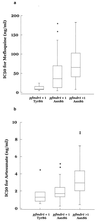The pfmdr1 gene is associated with a multidrug-resistant phenotype in Plasmodium falciparum from the western border of Thailand
- PMID: 10582887
- PMCID: PMC89592
- DOI: 10.1128/AAC.43.12.2943
The pfmdr1 gene is associated with a multidrug-resistant phenotype in Plasmodium falciparum from the western border of Thailand
Abstract
On the western border of Thailand, Plasmodium falciparum has become resistant to almost all antimalarial agents. The molecular basis of resistance in these parasite populations has not been well characterized. This study assessed genetic polymorphisms in the pfmdr1 gene in 54 parasites collected from the western border of Thailand to determine the relationship of pfmdr1 copy number and codon mutations with parasite sensitivities to mefloquine, chloroquine, halofantrine, quinine, and artesunate assessed in vitro. A point mutation at codon 86 (resulting in a change of Asn to Tyr) was associated with a significantly lower 50% inhibitory concentration (IC(50)) of mefloquine (median, 9 ng/ml versus 52.4 ng/ml; P = 0.003). Overall 35% of the isolates (19 of 54) had an increase in pfmdr1 copy number, and all 19 carried the wild-type allele at codon 86. Increased pfmdr1 copy number was associated with higher IC(50)s of mefloquine (P = 0.04) and artesunate (P = 0.005), independent of polymorphism at codon 86. The relationship between pfmdr1 and resistance to structurally distinct antimalarial agents confirms the presence of a true multidrug-resistant phenotype.
Figures

References
-
- Adagu I S, Dias F, Pinheiro L, Rombo L, do Rosario V, Warhurst D C. Guinea Bissau: association of chloroquine resistance of Plasmodium falciparum with the Tyr86 allele of the multiple drug resistance gene Pfmdr1. Trans R Soc Trop Med Hyg. 1996;90:90–91. . (Letter.) - PubMed
-
- Awad el Kariem F M, Miles M A, Warhurst D C. Chloroquine-resistant Plasmodium falciparum isolates from The Sudan lack two mutations in the pfmdr1 gene thought to be associated with chloroquine resistance. Trans R Soc Trop Med Hyg. 1992;86:587–589. - PubMed
-
- Basco L K, Eldin de Pecoulas P, Le Bras J, Wilson C M. Plasmodium falciparum: molecular characterization of multidrug-resistant Cambodian isolates. Exp Parasitol. 1996;82:97–103. - PubMed
-
- Basco L K, Le Bras J. In vitro activity of halofantrine and its relationship to other standard antimalarial drugs against African isolates and clones of Plasmodium falciparum. Am J Trop Med Hyg. 1992;47:521–527. - PubMed
-
- Basco L K, Le Bras J, Rhoades Z, Wilson C M. Analysis of pfmdr1 and drug susceptibility in fresh isolates of Plasmodium falciparum from subsaharan Africa. Mol Biochem Parasitol. 1995;74:157–166. - PubMed
Publication types
MeSH terms
Substances
Grants and funding
LinkOut - more resources
Full Text Sources

